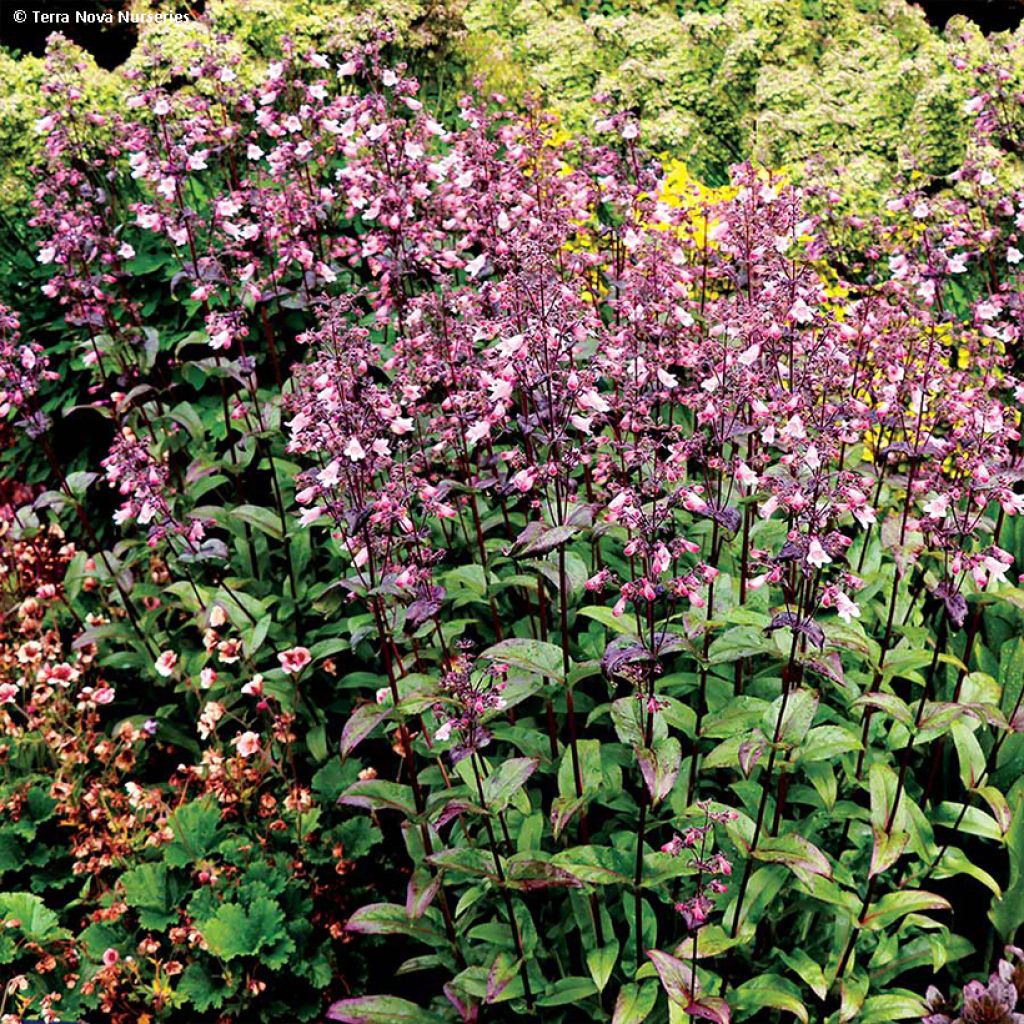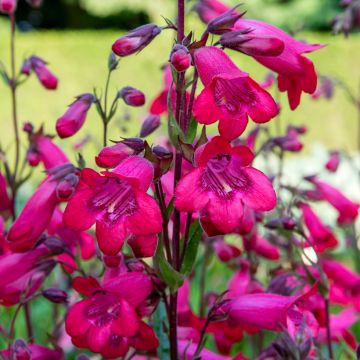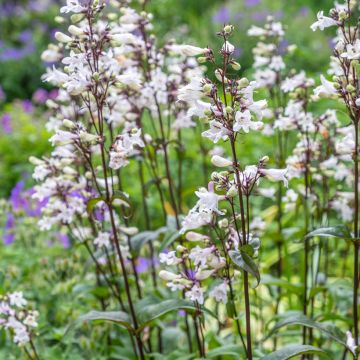

Penstemon digitalis Dakota Verde (Dakota Series) - Galane


Penstemon digitalis Dakota Verde (Dakota Series) - Galane


Penstemon digitalis Dakota Verde (Dakota Series) - Galane
Penstemon digitalis Dakota Verde - Foxglove beardtongue
Penstemon digitalis Dakota Verde
Foxglove Beardtongue, Smooth White Beardtongue
This item cannot be shipped to the selected country
Delivery charge from €5.90
More information
Schedule delivery date,
and select date in basket
This plant carries a 12 months recovery warranty
More information
We guarantee the quality of our plants for a full growing cycle, and will replace at our expense any plant that fails to recover under normal climatic and planting conditions.
From €5.90 for pickup delivery and €6.90 for home delivery
Express home delivery from €8.90.
Does this plant fit my garden?
Set up your Plantfit profile →
Description
The Penstemon digitalis 'Dakota Verde' is a remarkably compact variety with shiny foliage in a bright green colour, turning dark purple towards the end of the season. On its low, bushy growth, numerous lavender-pink flowers bloom in summer, borne in dense clusters. Invite it onto your terrace, in a border, a flower bed, or even among your favourite bush roses. Its combination with the Agastache Blue Boa is particularly successful.
The Penstemon digitalis belongs to the Scrophulariaceae family, like the foxglove, whose flowers are similar. The 'digitalis' penstemon is native to North America. It is mainly found in the eastern and southeastern United States, growing in dry areas such as prairies or open forests on well-drained, loamy or sandy soil. The 'Dakota Verde' variety, recently introduced from the USA, is part of a line of hybrids called the Dakota Series, selected for their small size, hardiness, and beautiful colours.
The Penstemon 'Dakota Verde' develops from a robust base, forming a basal rosette of shiny leaves, then a clump of leafy stems slightly more comprehensive than tall (about 35 cm (14in) tall and 45 cm (18in) wide). The colour of the leaves gradually changes from bright green to dark green in summer, eventually turning dark purple. In July, thick, hairy, deep burgundy-red stems rise, not exceeding 60 cm (24in) in height. They are adorned with smaller leaves and bear tubular flowers, crowned with five lobes at their tips. The flowers are grouped in pairs on beautiful clusters measuring 15 cm (6in) in length. They have a pinkish-mauve colour. This variety is hardy in well-drained soil. Its foliage is semi-evergreen in winter.
The 'Dakota Verde' penstemon fits well in a perennial or shrub border with plenty of sun. It can be paired with romantic bush roses (Bouquet Parfait, Pomponella) or the tiny Physocarpus Little Devil, which is also very dark. But also in a more minimalist style, with beautiful blue grasses like blue fescues or Schizachyrium scoparium Prairie Blues. It will also blend well with the blue blooms of campanulas and annual lobelias. This small penstemon also performs well in a pot, with proper drainage and regular fertiliser application. Penstemons also make excellent cut flowers.
Report an error about the product description
Flowering
Foliage
Plant habit
Botanical data
Penstemon
digitalis
Dakota Verde
Scrophulariaceae
Foxglove Beardtongue, Smooth White Beardtongue
Cultivar or hybrid
Other Penstemon
Planting and care
The Penstemon digitalis 'Dakota Verde' is a plant that prefers to be in a sunny location, although it can also handle some shade in very sunny areas. It likes soil that is light, rich, and well-drained, but not too dry during the summer. It can tolerate some limestone, but slightly acidic soil is best. It is relatively easy to grow and does not require too much attention, but it does not like winter humidity.
This plant is quite hardy and can withstand temperatures down to approximately -15°C (5°F), provided that the soil does not hold water. It is important not to cut back the clump at the end of the season because the vegetation plays a role in regulating soil moisture. In early winter, the base can be protected with a mulch of dry leaves or crushed sand and gravel to improve drainage and prevent collar rot caused by excessive moisture.
Planting can be done in the autumn or spring. It is beneficial to add some light fertilizer at this time but avoid any fertiliser afterwards to prevent the Penstemon from having weak and loose stems. Penstemons are generally resistant to diseases, but they can be susceptible to powdery mildew or downy mildew and can be attacked by snails, slugs, and chrysanthemum nematodes.
Planting period
Intended location
Care
This item has not been reviewed yet - be the first to leave a review about it.
Summer flowering perennials
Haven't found what you were looking for?
Hardiness is the lowest winter temperature a plant can endure without suffering serious damage or even dying. However, hardiness is affected by location (a sheltered area, such as a patio), protection (winter cover) and soil type (hardiness is improved by well-drained soil).

Photo Sharing Terms & Conditions
In order to encourage gardeners to interact and share their experiences, Promesse de fleurs offers various media enabling content to be uploaded onto its Site - in particular via the ‘Photo sharing’ module.
The User agrees to refrain from:
- Posting any content that is illegal, prejudicial, insulting, racist, inciteful to hatred, revisionist, contrary to public decency, that infringes on privacy or on the privacy rights of third parties, in particular the publicity rights of persons and goods, intellectual property rights, or the right to privacy.
- Submitting content on behalf of a third party;
- Impersonate the identity of a third party and/or publish any personal information about a third party;
In general, the User undertakes to refrain from any unethical behaviour.
All Content (in particular text, comments, files, images, photos, videos, creative works, etc.), which may be subject to property or intellectual property rights, image or other private rights, shall remain the property of the User, subject to the limited rights granted by the terms of the licence granted by Promesse de fleurs as stated below. Users are at liberty to publish or not to publish such Content on the Site, notably via the ‘Photo Sharing’ facility, and accept that this Content shall be made public and freely accessible, notably on the Internet.
Users further acknowledge, undertake to have ,and guarantee that they hold all necessary rights and permissions to publish such material on the Site, in particular with regard to the legislation in force pertaining to any privacy, property, intellectual property, image, or contractual rights, or rights of any other nature. By publishing such Content on the Site, Users acknowledge accepting full liability as publishers of the Content within the meaning of the law, and grant Promesse de fleurs, free of charge, an inclusive, worldwide licence for the said Content for the entire duration of its publication, including all reproduction, representation, up/downloading, displaying, performing, transmission, and storage rights.
Users also grant permission for their name to be linked to the Content and accept that this link may not always be made available.
By engaging in posting material, Users consent to their Content becoming automatically accessible on the Internet, in particular on other sites and/or blogs and/or web pages of the Promesse de fleurs site, including in particular social pages and the Promesse de fleurs catalogue.
Users may secure the removal of entrusted content free of charge by issuing a simple request via our contact form.
The flowering period indicated on our website applies to countries and regions located in USDA zone 8 (France, the United Kingdom, Ireland, the Netherlands, etc.)
It will vary according to where you live:
- In zones 9 to 10 (Italy, Spain, Greece, etc.), flowering will occur about 2 to 4 weeks earlier.
- In zones 6 to 7 (Germany, Poland, Slovenia, and lower mountainous regions), flowering will be delayed by 2 to 3 weeks.
- In zone 5 (Central Europe, Scandinavia), blooming will be delayed by 3 to 5 weeks.
In temperate climates, pruning of spring-flowering shrubs (forsythia, spireas, etc.) should be done just after flowering.
Pruning of summer-flowering shrubs (Indian Lilac, Perovskia, etc.) can be done in winter or spring.
In cold regions as well as with frost-sensitive plants, avoid pruning too early when severe frosts may still occur.
The planting period indicated on our website applies to countries and regions located in USDA zone 8 (France, United Kingdom, Ireland, Netherlands).
It will vary according to where you live:
- In Mediterranean zones (Marseille, Madrid, Milan, etc.), autumn and winter are the best planting periods.
- In continental zones (Strasbourg, Munich, Vienna, etc.), delay planting by 2 to 3 weeks in spring and bring it forward by 2 to 4 weeks in autumn.
- In mountainous regions (the Alps, Pyrenees, Carpathians, etc.), it is best to plant in late spring (May-June) or late summer (August-September).
The harvesting period indicated on our website applies to countries and regions in USDA zone 8 (France, England, Ireland, the Netherlands).
In colder areas (Scandinavia, Poland, Austria...) fruit and vegetable harvests are likely to be delayed by 3-4 weeks.
In warmer areas (Italy, Spain, Greece, etc.), harvesting will probably take place earlier, depending on weather conditions.
The sowing periods indicated on our website apply to countries and regions within USDA Zone 8 (France, UK, Ireland, Netherlands).
In colder areas (Scandinavia, Poland, Austria...), delay any outdoor sowing by 3-4 weeks, or sow under glass.
In warmer climes (Italy, Spain, Greece, etc.), bring outdoor sowing forward by a few weeks.























































